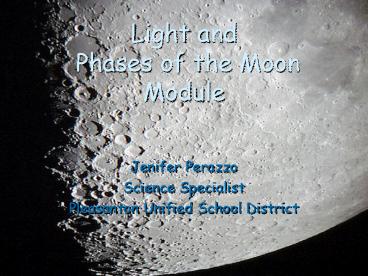Light and Phases of the Moon Module - PowerPoint PPT Presentation
1 / 24
Title: Light and Phases of the Moon Module
1
Light and Phases of the Moon Module
- Jenifer Perazzo
- Science Specialist
- Pleasanton Unified School District
2
Appreciation
- Dr. Carl Pennypacker, Lawrence Berkeley
Laboratory - IISME Teacher Program
- Center for Science Engineering Education
- Bellevue School District
- Bill Melinda Gates Foundation
- Pleasanton Unified School District
3
Overview
- Research Development
- Curriculum
- Piloting Process New Discoveries
- Global Science Education- HOU
- Future Plans
4
Research
- The theories children build, whether they are
right or wrong, are not capricious. They are
often logical and rational, and firmly based in
evidence and experience. - (Inquiry Thoughts, Views, and Strategies for the
K-5 Classroom. National Science Foundation. )
5
Preconceptions
- Preconceived notions, non-scientific beliefs,
naive theories, mixed conceptions, intelligent
wrong answers, or conceptual misunderstandings. - Children do not want to give up the concepts and
theories they work so hard to make. - (Inquiry Thoughts, Views, and Strategies for the
K-5 Classroom. National Science Foundation.)
6
Preconception of Light
- A shadow is something that exists on its own.
Light pushes the shadow away from the object to
the wall or the ground and is thought of as a
"dark " reflection of the object. - The phases of the moon are caused by shadows cast
on its surface by other objects in the solar
system. - (Operation Physics Elementary/middle school
physics education outreach project of the
American Institute of Physics.) - Where Does the Old Moon Go When We Get a New
One? - (Vision (1974 Agathon Press), David Hawkins,
philosopher of science and director of the
Elementary Science Study (ESS))
7
Development of Unit
- Big Picture
- Pedagogical Sequencing
- Prediction (individual)
- Group (adjustments)
- Class (adjustments)
- Testing
- Compare/Contrast
- Conclusion/Communication
- Claim, Evidence, Reasoning
- Next Step??
8
Light and Phases of the Moon
- Overview
- QuickCams and SalsaJ image processing to explain
the phases of the moon. - Use of manipulatives to orchestrate the position
of the Earth, Moon and Sun during a particular
phase. - Laser tests conquers the properties of light
- Light interacts with matter that allows us to
see - Light Scatters in many different directions
- Function of the eye and relating it to the
QuickCam
9
Investigation 1.1 How does light travel from a
laser pointer to your eye?
- Objective Light comes from a source and travels
to our eyes.
10
Investigation 1.1 Class Prediction
11
Investigation 1.1 Sample Conclusion
12
Investigation 1.2 How does light travel from a
laser pointer to your eye, after interacting with
matter?
- Objective Light scattering off matter allowing
us to see.
13
Investigation 1.2Class Prediction
14
Investigation 2.1 How does a QuickCam capture an
image?
- Objective QuickCam is a devise that captures
light, like the eye, and - displays it as pixels.
15
Investigation 2.1Sample Prediction
16
Investigation 2.2 How does SalsaJ analyze light
from an image?
- Objective SalsaJ extracts the data from image
pixels and converts it into a graph allowing for
analysis.
17
Investigation 2.2Sample Predictions
18
Investigation 2.3 How will the laser light graph
in Salsa J?
- Objective To measure light scattered from the
laser.
19
Investigation 3.1 How does studying light helps
us understand the Phases of the Moon?
- Objective Understanding the properties of light
allow us to correctly predict the position of the
Earth, Moon and Sun during a particular phase.
20
Investigation 3.1- Moon Phase Results
21
Oreo Cookie Moon Phases!!
- Objective Extension lesson
- Yummy!
22
Overall Findings
- Children find it extremely difficult to give up
their previous understandings the universe. - These beliefs are then molded by what their
culture tells them about the earth moon and
stars. - This process can often times lead to naïve
models in the science. - (Taking Science to School, National Research
Council, 2007. - Uncomfortable with not having the answers by
the end of the class.
23
Future Plans
- Develop pre/post assessments for unit
- Bellevue Teacher Professional Development
- Advancing my own personal and professional life
through obtaining a higher degree - Develop a primitive unit for 3rd grade based on
Light Energy
24
The Big Bang!!































